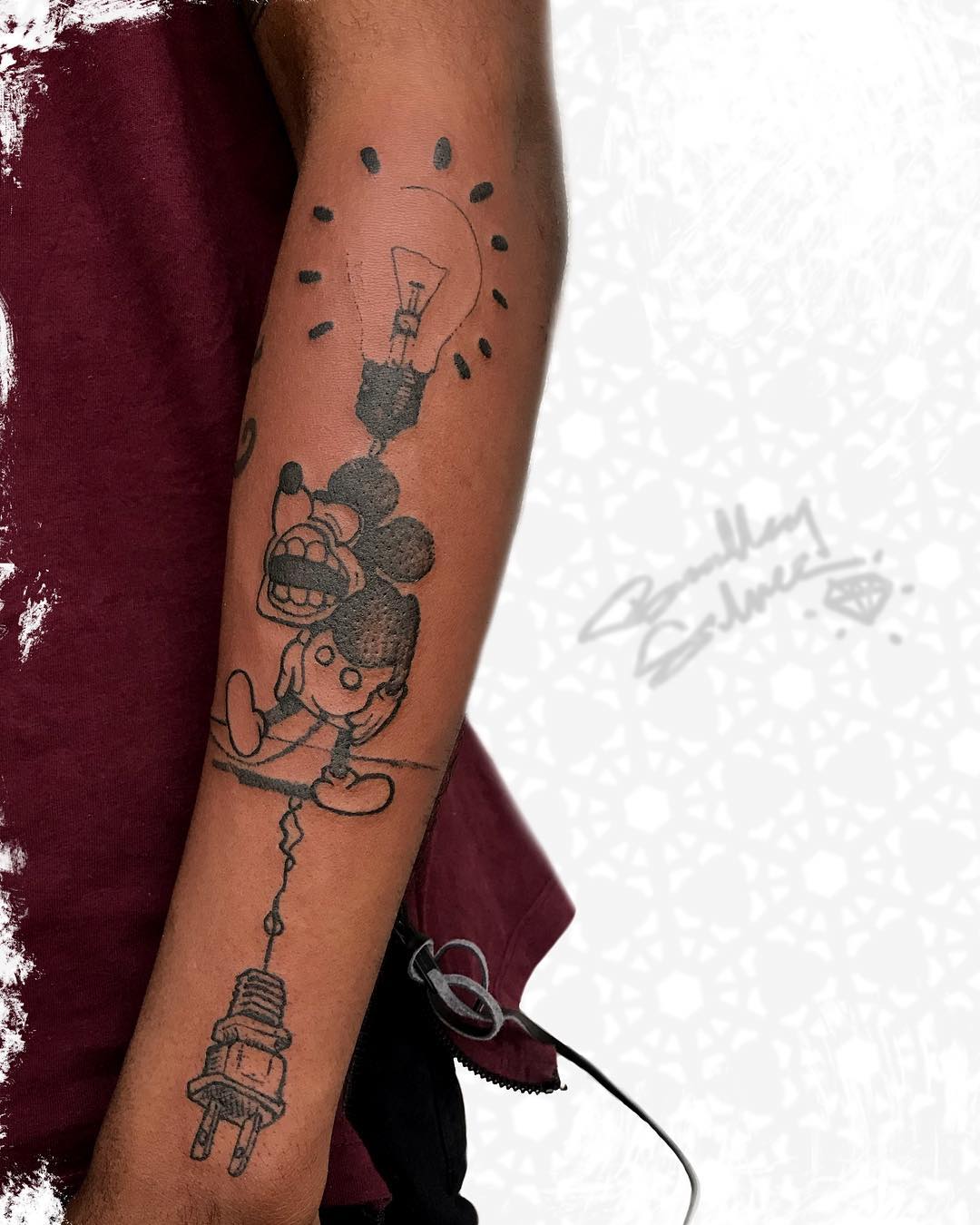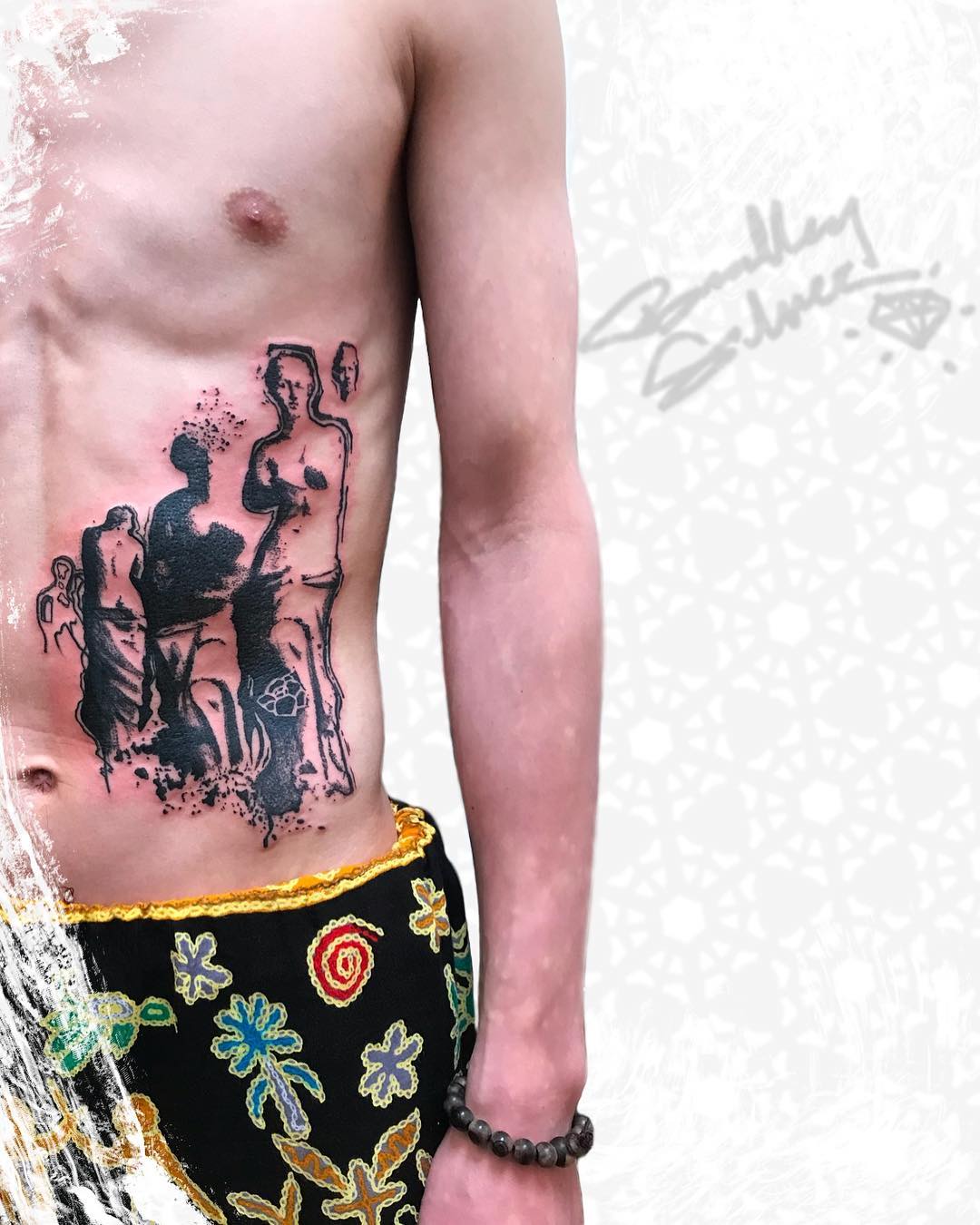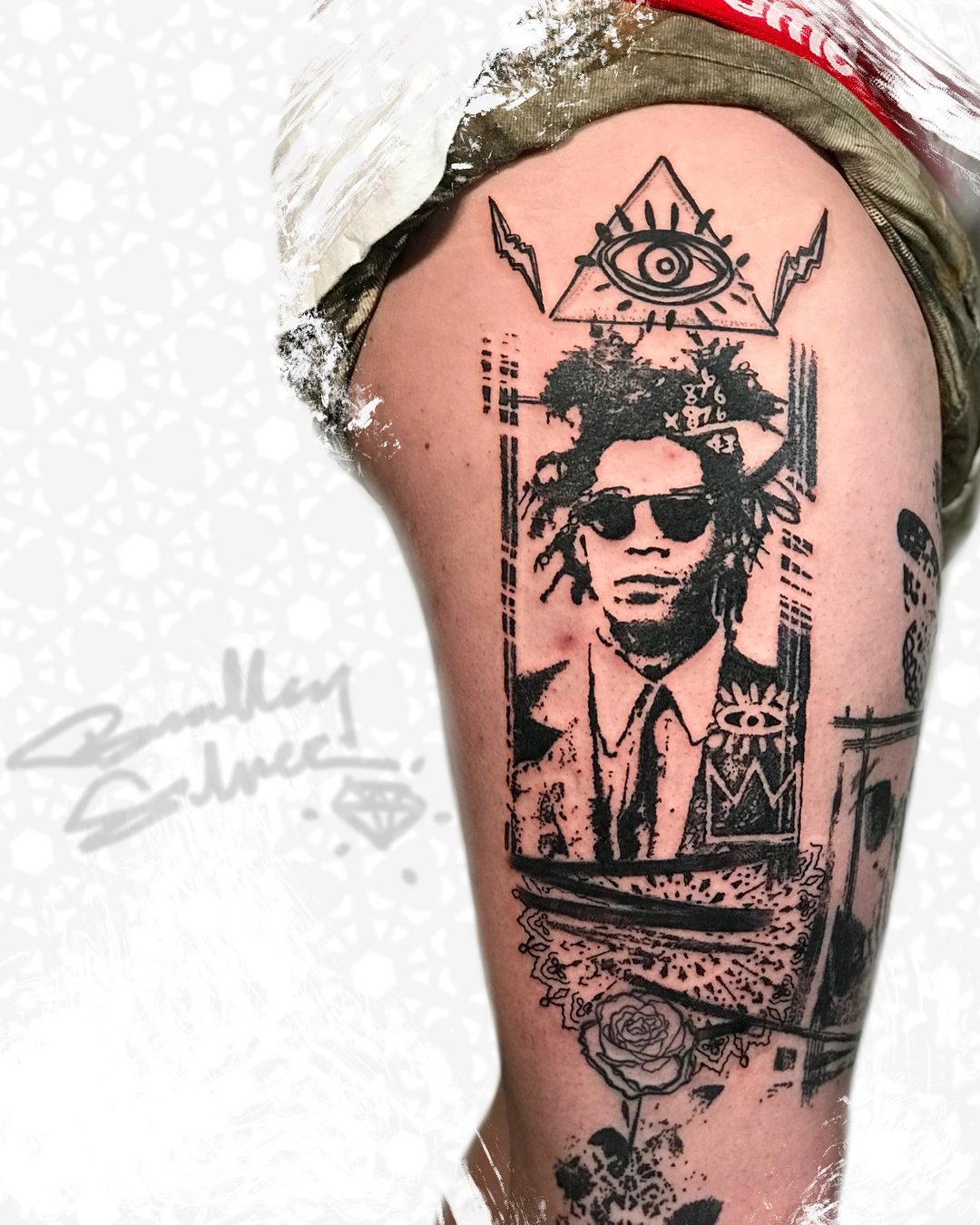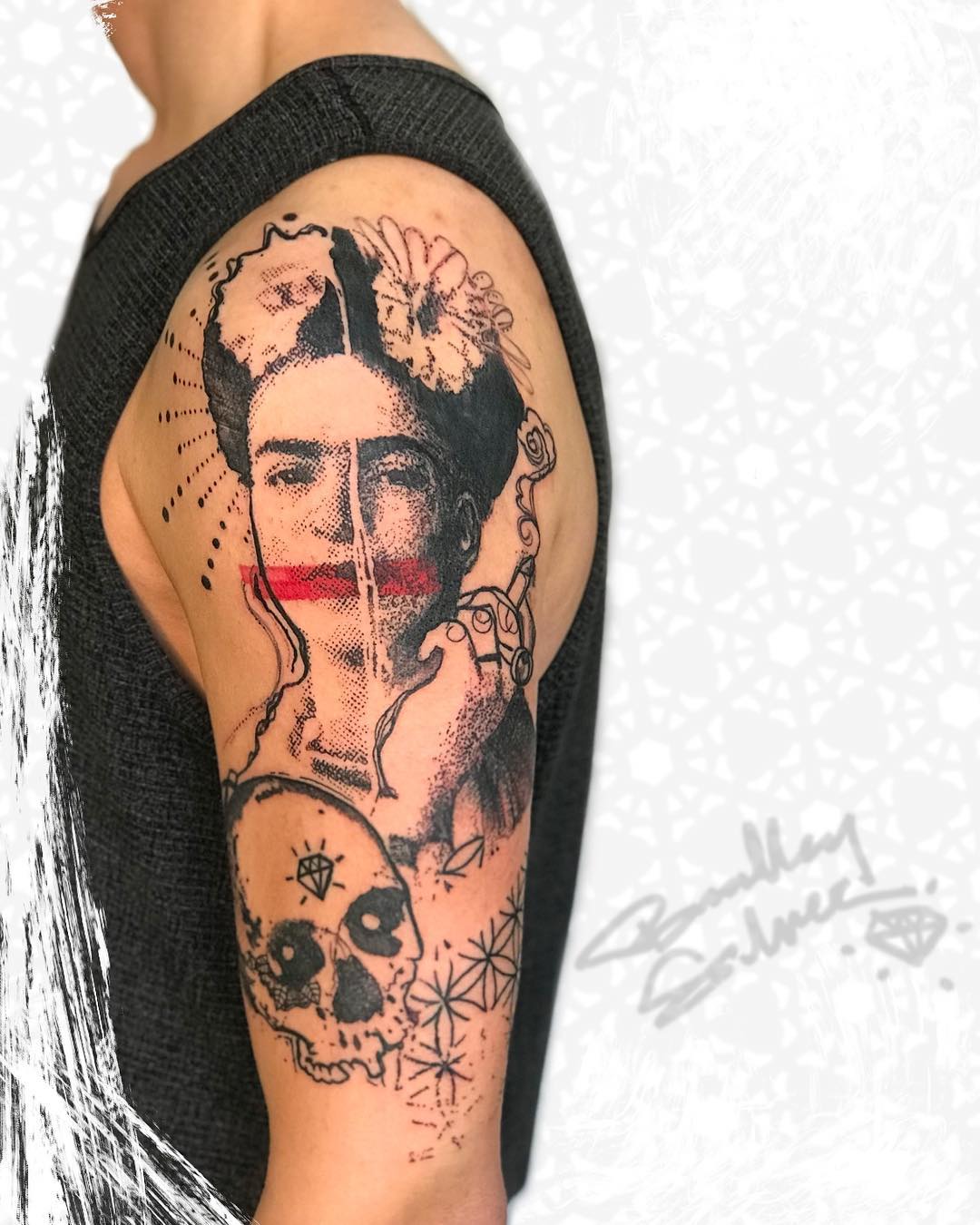
Avant-garde tattoo artist Bradley Silver wants to change how you see yourself in the mirror. Miles away from traditional Americana tattoos, his modern artwork spans the architecture of the body, tailored to the individual. It’s a way for his clients to take back control of their bodies, while expressing themselves in the process.
Silver was attracted to tattooing for the same reason he loves street art: there’s no resale value, so it can’t be corrupted by fine art markets. “It’s just for us,” he tells me. “This art lives with us, it breathes with us, it dies with us. No one can take that away.”
This personalized valuation of art is a major reason Silver’s tattoo aesthetic mimics street art. He uses varying needle widths and wild hand gestures to simulate the textures of spray cans, stencils, markers, and wheatpaste, on the human body. He does this intentionally, to draw a parallel between the two art forms.
I sat down with him at his studio, White Rabbit Tattoo, in the Lower East Side of New York. We discussed the political intersection of body art and street art, as well as the emotional significance of wearing something that can’t be resold.
***
The Rumpus: Why draw a parallel between street art and tattooing?
Bradley Silver: Street art is meant to be viewed and admired by the public. And it’s free to those who know where to look, or are lucky enough to be in the right spot at the right time. Messages vary, of course, but there are usually themes that represent the voice of the general public. They are often about some kind of revolution, commenting against the practices of big business, government, or social structures.
This is the type of art that particularly inspires me. Why not send these messages of inspiration and awe on a tour all over the globe by putting them on skin? When people see each others’ tattoos, why not be inspired in the same way as they might be by a prolific street artist, or any other artist, for that matter?
I am always looking at people’s tattoos, and know they’re looking at mine. I overhear conversations about tattoos on the street, whether of admiration, aspiration, or taboo. I understand, in those moments, how one person’s tattoos can inspire others to explore their own self truths. Tattoos can inspire strangers to think about a universal truth, or even realize a call to action to awaken themselves. It can be powerful.
The same effect can happen when we experience street art and fine art (though the latter, I think, is generally less accessible to the public, so as a result is often more classist in practice). In my mind, all of the arts share the power to create change in the way people view themselves, and humanity as a whole.
Rumpus: What kinds of messages do you put into your work, and why?
Silver: My art often rejects the West’s worship of money, popular culture, and celebrities. The treatment of celebrities as deities is a problem. It’s dangerous to idolize another person like a god. I see media and popular culture as modern religions. They tell you what to think, how to act, and take your money. I should add that I am not immune to the efforts of the powers that be, but it is important for us to acknowledge the ways they push back on free thinkers. They don’t want us to be united, so they can continue to rule us more easily.
Perhaps less controversially, I also like creating pieces about self acceptance, and acceptance of one another. I like highlighting anything that makes us unique, especially by criticizing the standards of beauty dictated by corporate marketing campaigns. If we are able to see all of our differences as positive, or at least interesting, maybe that could be a step toward a more unified community that puts human rights ahead of profits. At the very least, I hope to impact the life of each person who wears my art, and the people in their orbit.
Rumpus: Do your messages speak for the clients who wear them?
Silver: I create a lot of custom tattoos for people who want to express emotions and political positions that coincide with my beliefs. So, yes. In some capacity, these ideas must resonate with most of my clientele. I’ve even had a handful of people choose ready-made artwork—pieces that I designed for my own reasons—because they’re on board with the message.
It’s not for everyone, though, and I certainly will never push any agenda on my clients. Part of my job is to create custom art based on what they want to represent. People get tattoos for so many different reasons.
But I will say, when there is some message about social issues, it is often esoteric in its symbolism. Others will usually just think it’s an interesting piece of art. Without tattooing text to clearly write out a specific message, passersby won’t get to the bottom of a tattoo’s meaning unless they engage in conversation with the person wearing it. Hopefully, they’ll start that conversation with my clients, and walk away feeling inspired.
Rumpus: Is there an average type of client drawn your portfolio?
Silver: My clients are quite varied, from students to professionals, different ages, genders, and races. It might be easier to single out a type of client that I don’t often tattoo.
My shop, White Rabbit Tattoo, is quite opinionated and liberal. We are not shy. During the day, there is a fair amount of conversation and friendly banter between artists. Clients are always welcome to join our conversations, and often do. I speak very candidly with my clients, and have a lot of interesting conversations with them. It’s not rare to have meaningful conversations involving politics, human rights issues, gender, and sexual orientation. I have never heard a comment by any client or artist at our shop that lead me to believe they carry racist, sexist, anti-gay, or radical right wing values. I guess, besides my art uniting my clients, another common characteristic is that they are liberal and open-minded.
Rumpus: You’ve shared the political reasons for aligning tattooing with street art. How, aesthetically and technically, do the tools of street art influence your designs?
Silver: Besides the deeper connections between tattoos and street art, the broad aesthetic (spray cans, stencils, wheatpaste) translate nicely to skin. Bold lines with high contrast imagery are great for tattooing.
To simulate spray cans, I lean toward the spatter, or “drip” look. It creates a feeling of spontaneity, messiness, and a bit of anarchy. In the design process, my mind lets go at that moment, allowing the paint to put on its own performance. The surprise and the chaos of it leaves me feeling liberated.
Stencils, in street art, are the exact opposite. They are carefully planned designs that can be applied quickly. One of the masters, and most recognized artists to do this, is Banksy (also one of my biggest inspirations). For me, he really opened up the possibility for street art to be more than just graffiti, with his messages and clever anti-establishment hijinks. So, the two-toned stencil look, while applied at a much slower pace (needles to skin, rather than a quick spray of a can), is a cornerstone aesthetic in my work.
Rumpus: Does the impact of this style change when it’s no longer temporary, and the medium is a human being?
Silver: It certainly does change, but it’s not a matter of longevity. People can always choose to cover tattoos, or get them removed, just as easily as a building can get demolished or power-washed. Some street art will last longer than some tattoos. There is a Space Invader mosaic that I’ve been able to view for the past eight years. But, just the other day, I covered a one-month-old tattoo for a client. So, the words “temporary” or “permanent” are all relative.
The two main differences between street art and tattooing, as I see it, are size and mobility. The human body’s size, of course, limits the artwork. When a tattoo spans across the entire body, it is a magnificent feat. But at a certain point, it just can’t get any bigger.
On the other hand, a building’s wall can accommodate work that spans multiple stories. When I see a mural at that scale, it is awe-inspiring. A perfect example is Faith XLVII. Hers is some of the most enormous artwork I’ve ever seen, and it blurs the boundaries between fine art and street art, in terms of technique. For me, it would probably take hundreds of people to agree to be a part of one continuous tattoo across all of their bodies, for me to create something of the same magnitude in the medium of tattooing.
While street art is generally confined to walls (thus immobile), tattoos are free to travel anywhere. I love hearing stories from clients whose tattoos were recognized on the other side of the world by complete strangers. Many of my clients are stopped in the street and asked, “Is that a Bradley Silver tattoo?” It is remarkable, and humbling, to create something that is so recognizable. I also love that I don’t personally have to travel for my artwork to reach all corners of the earth.
Rumpus: We’ve discussed the distinctions between the art forms, but one major similarity you highlighted is the lack of resale value. Is it important for you to create art with no resale value?
Silver: I don’t know how important that trait is for all art, but I do enjoy the fact that there is no resale value for tattoos. Each tattoo that I make is specific to the client who wears it, and only they can determine its value. I will never duplicate a tattoo, so no one else can ever own that design. I feel that tattooing is sacred, in this way. This art lives with us, it breathes with us, it dies with us. No one can take that away.
I wouldn’t, however, have a problem using my designs to “sell out” just a little (not designs that have been tattooed, of course), maybe to an apparel company or something of the sort. The goal of a move like that would be to broaden my audience, and to make some money in the process. As much as I can condemn the greed of the super wealthy, I do have to “play the game” of capitalism a bit to continue doing the work I love. That’s a struggle of most people who want to battle a system, but still have to live within the system. That said, I am fortunate enough that art is my career. And I am supporting my family in doing this, so I’m making as much money as I can, while I can.
If, at some point, my tattooing career slows down and my fine art picks back up, I can’t say that I would be sad to sell work for substantial amounts of money to collectors. If the world doesn’t change, and wealth isn’t distributed fairly to the people who work hard to earn a living, it would be nice to be in a position of greater power, to put my extra money to good use. Unfortunately, right now, most of my earnings are tied up in rent, food, health care, tattoo supplies, and the occasional R&R needed for a healthy mind. No harm in dreaming big though, right?
Rumpus: Fair enough. You often put fine art references in your tattoos, though. If the intention is to separate the ethos of tattooing from that of the fine art market, why make these references?
Silver: The global fine art market does tend to corrupt the original intent of great artists by using them for capital gain. However, I feel these artists usually deserve the status of an icon. They deserve to be idolized by the public, despite how they’ve been commercialized or watered down by wealthy collectors and big businesses.
Many times, when a fine art icon is depicted in one of my tattoos, it’s at the request of a client. For them, these artists don’t represent the super rich, but rather serve as expressions of passionate ideas and radical life stories. They relate to the artists, or they’ve been personally moved by the artists’ work, and I’m happy to see this still happens, even after an artist has become commodified.
For example, Frida Kahlo is an inspiration to so many women, Latinx people, and anyone with physical disabilities. I put her likeness in a tattoo recently. She is a great example for people to be comfortable with what makes them physically unique, and to overcome social adversity. And Basquiat, another popular subject for tattoos, is the precursor to a lot of street artists, in my opinion. He also happens to be a big influence of mine, in both aesthetics and political statements. His work often carries a message that calls out socio-economic issues, corporate and political corruption. He was always radical, and always struggled with the same pressures that I’ve discussed here.
The fine art market is not always for people who admire art, though. It’s usually for investors who treat art as a commodity to trade, and to make a profit. So, the fine artist isn’t the problem. The market is the problem.
Rumpus: You’ve said you want to change the way people think about tattoos, and their own bodies. What changes are you hoping to see?
Silver: I want to see people get more unique ideas that have an intellectual or philosophical message, rather than just pluck a picture from Pinterest and stamp it on themselves.
I’m also always encouraging people to open their minds to larger projects that span across the body. For example, imagine the impact of a piece that goes from your leg up into the torso, from your chest onto the arms, or a composition that covers your entire front, or back of your body. These types of tattoos allow a special kind of creativity for me, and often amaze people when they walk into a room. When you add interesting subject matter, or a personal statement to this equation, it can get people thinking of tattoos the same way people think about other “higher” art forms.
These works really open everyone’s minds to the possibility of what a “tattoo” can be. And they have the power to revolutionize the way you see yourself in the mirror, altering the overall relationship you have with your body.








